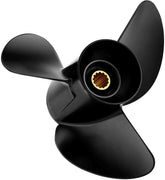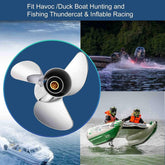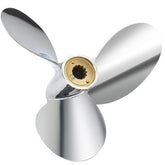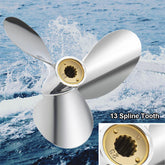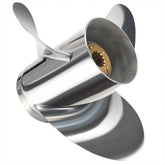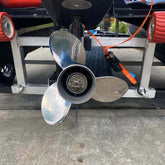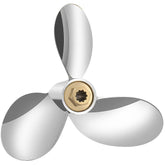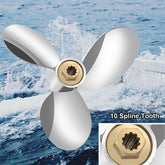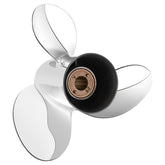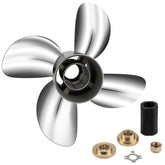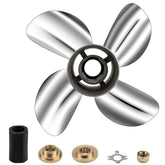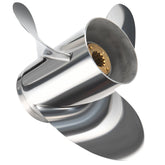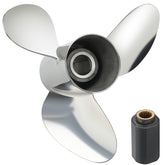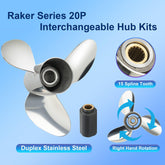Aluminum Propellers for 60–140HP Tohasu Outboard Boat Motor
When you’re pushing the limits of performance on the water, every detail matters—especially the propeller slicing through the wake. Our line of aluminum propellers for 60–140HP Tohasu outboards is engineered to deliver smooth acceleration, crisp throttle response, and reliable top-end speed. While we aren’t the official propeller supplier for Yamaha or Mercury, these blades are precision-shaped to fit their 4¼″ gearcases—and to bring out the best in your boating experience.
Why Choose Our Aluminum Propellers?
-
Tailored Fit
Designed specifically for 15-spline, 4¼″ gearcases on 60–140HP motors (including TLDI models), each propeller snaps on easily and maintains perfect clearance under load. -
Lightweight Durability
High-quality aluminum construction keeps weight down without sacrificing strength. That means less drag at the top end and better fuel efficiency over long runs. -
Optimized Blade Geometry
We’ve experimented with blade count, diameter, and pitch to strike the sweet spot between hole-shot grunt and planing-ease. You get reliable hole-through-water grip and stable cruising RPM. -
Versatility Across Brands
Although these props aren’t official Yamaha, Mercury, Suzuki, Volvo, or Honda parts, they’ve proven themselves as drop-in replacements on all of those 60–140HP 4¼″ gearcases—so you can mix, match, and upgrade without missing a beat.
Propeller Specifications
Below is a comprehensive breakdown of each prop design, organized by blade count (B), diameter (D), pitch (P), rotation (R), and the OEM numbers they replace. Use this as a quick-reference guide to pick the perfect match for your engine year and horsepower.
| OEM # | Blades (B) | Diameter (D) | Pitch (P) | Rotation (R) |
|---|---|---|---|---|
| — | 3 | 12 ¾″ | 21″ | R |
| 3HKB64541-0 | 3 | 13″ | 19″ | R |
| 3HKB64541-0 | 3 | 13.2″ | 19″ | R |
| 3HKB64545-0 | 3 | 13.2″ | 21″ | R |
| 3HKB64536-0 | 3 | 13¼″ | 17″ | R |
| 3HKB64532-0 | 3 | 13½″ | 15″ | R |
| 3HKB64527-0 | 3 | 13 5⁄8″ | 13″ | R |
| 3HKB64527-0 | 3 | 13 ¾″ | 13″ | R |
| 3HKB64532-0 | 3 | 13 ¾″ | 15″ | R |
| 3HKB64518-0 | 3 | 14″ | 9″ | R |
| — | 3 | 14″ | 10″ | R |
| 3HKB64523-0 | 3 | 14″ | 11″ | R |
| 3HKB64525-0 | 3 | 14″ | 13″ | R |
| — | 3 | 14″ | 15″ | R |
| — | 3 | 14″ | 17″ | R |
| — | 3 | 14″ | 19″ | R |
| — | 3 | 14″ | 21″ | R |
| 58100-90J31-019 | 3 | 14″ | 23″ | R |
| — | 4 | 12 ½″ | 19″ | R |
| — | 4 | 13″ | 15″ | R |
| — | 4 | 13″ | 17″ | R |
| — | 4 | 13″ | 19″ | R |
| — | 4 | 13.4″ | 15″ | R |
| — | 4 | 13.8″ | 10″ | R |
| — | 4 | 13.8″ | 11″ | R |
| — | 4 | 13.8″ | 13″ | R |
| — | 4 | 14″ | 13″ | R |
| — | 4 | 14″ | 15″ | R |
| — | 4 | 14″ | 17″ | R |
| — | 4 | 14″ | 19″ | R |
| — | 4 | 14″ | 21″ | R |
Matching Propellers to Your Outboard
-
Identify Your Horsepower & Year.
• Pre-2002 models (60C, 70C) typically favor the 3-blade, 13″ diameter with 19–21″ pitch for balanced acceleration and top speed.
• TLDI engines (70–90HP TLDI, 75HP models) often run best with slightly larger pitches—think 13¼″×17″ or 13½″×15″—to handle higher torque.
• Big-block 115–140HP motors (1988–2003) can take advantage of 14″ diameters and 9–13″ pitches when you want a punchy hole shot or 17–23″ when you’re chasing speed. -
Blade Count Matters.
• Three-blade props offer lighter load, quicker acceleration, and ease of maneuverability—ideal for general recreational boating.
• Four-blade designs increase grip and stability, which lends itself to heavy loads, water-skiing, or wakeboarding where you need a firm bite out of the hole. -
RPM & Fuel Efficiency.
Choosing a pitch that’s too steep can bog down the motor; too shallow, and you’ll spin out with wasted throttle. Use our chart to zero in on the pitch that delivers the manufacturer’s recommended cruise RPM (typically between 4,500 and 5,500 RPM).
Bringing It All Together
Whether you’re running flats, towing a skier, or just cruising with friends, the right aluminum propeller transforms your outboard’s performance. Our 60–140HP lineup covers every combination of blades, diameters, and pitches—so you can fine-tune your boat’s behavior on the water. Browse through the specifications above, pair the OEM replacement code with your model year, and get ready to feel the difference next time you hit the throttle!


